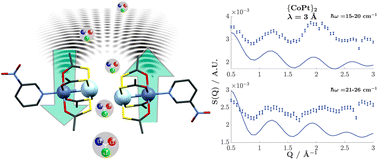Experimental assignment of long-range magnetic communication through Pd & Pt metallophilic contacts†
Abstract
Record-breaking magnetic exchange interactions have previously been reported for 3d-metal dimers of the form [M(Pt(SAc)4)(pyNO2)]2 (M = Ni or Co) that are linked in the solid state via metallophilic Pt⋯Pt bridges. This contrasts the terminally capped monomers [M(Pt(SAc)4)(py)2], for which neither metallophilic bridges nor magnetic exchange interactions are found. Computational modeling has shown that the magnetic exchange interaction is facilitated by the pseudo-closed shell d8⋯d8 metallophilic interaction between the filled Pt2+ 5dz2 orbitals. We present here inelastic neutron scattering experiments on these complexes, wherein the dimers present an oscillatory momentum-transfer-dependence of the magnetic transitions. This allows for the unequivocal experimental assignment of the distance between the coupled ions, which matches exactly the coupling pathway via the metallophilic bridges. Furthermore, we have synthesized and magnetically characterized the isostructural palladium-analogues. The magnetic coupling across the Pd⋯Pd bridge is found through SQUID-magnetometry and FD-FT THz-EPR spectroscopy to be much weaker than via the Pt⋯Pt bridge. The weaker coupling is traced to the larger radial extent of the 5dz2 orbitals compared to that of the 4dz2 orbitals. The existence of a palladium metallophilic interaction is evaluated computationally from potential surface cuts along the metal stretching direction. Similar behavior is found for the Pd⋯Pd and Pt⋯Pt-systems with clear minima along this coordinate and provide estimates for the force constant for this distortion. The estimated M⋯M stretching frequencies are found to match experimental observed, polarized bands in single-crystal Raman spectra close to 45 cm−1. This substantiates the existence of energetically relevant Pd⋯Pd metallophilic interactions. The unique properties of both Pt2+ and Pd2+ constitutes an orthogonal reactivity, which can be utilized for steering both the direction and strength of magnetic interactions.

- This article is part of the themed collection: 2023 Chemical Science HOT Article Collection


 Please wait while we load your content...
Please wait while we load your content...